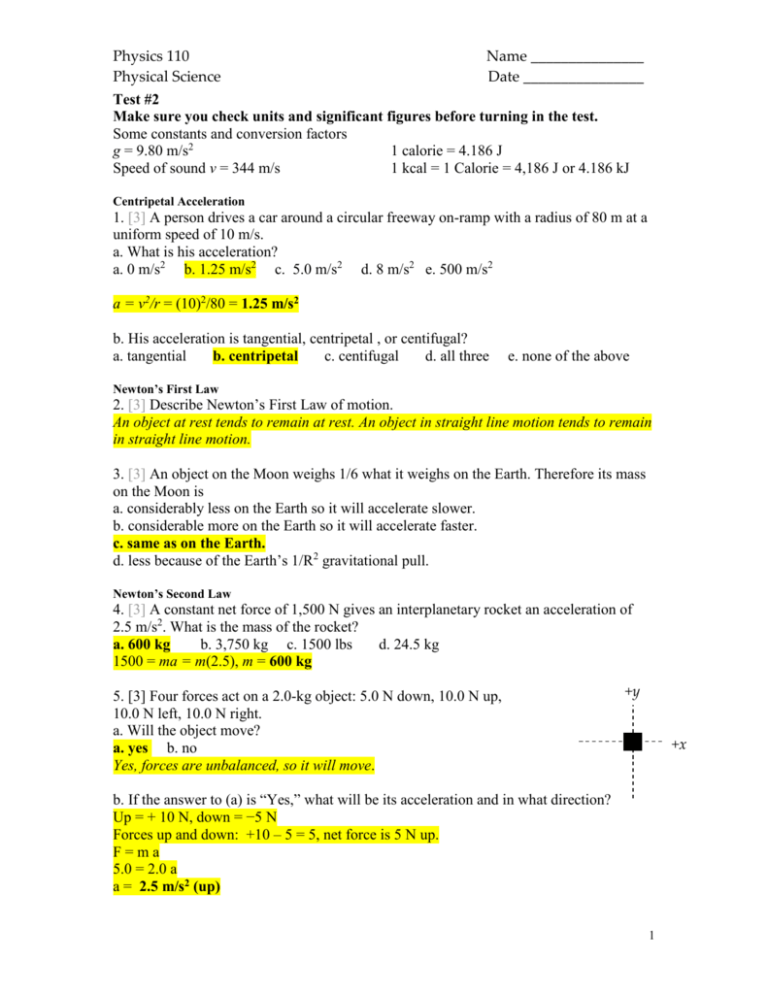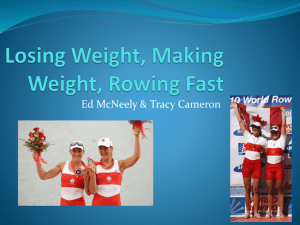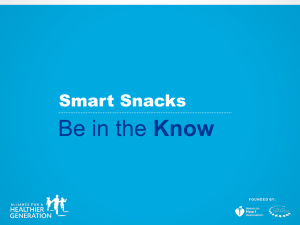Exercise #1 PHYC 251: General Physics
advertisement

Physics 110 Physical Science Name _______________ Date ________________ Test #2 Make sure you check units and significant figures before turning in the test. Some constants and conversion factors g = 9.80 m/s2 1 calorie = 4.186 J Speed of sound v = 344 m/s 1 kcal = 1 Calorie = 4,186 J or 4.186 kJ Centripetal Acceleration 1. [3] A person drives a car around a circular freeway on-ramp with a radius of 80 m at a uniform speed of 10 m/s. a. What is his acceleration? a. 0 m/s2 b. 1.25 m/s2 c. 5.0 m/s2 d. 8 m/s2 e. 500 m/s2 a = v2/r = (10)2/80 = 1.25 m/s2 b. His acceleration is tangential, centripetal , or centifugal? a. tangential b. centripetal c. centifugal d. all three e. none of the above Newton’s First Law 2. [3] Describe Newton’s First Law of motion. An object at rest tends to remain at rest. An object in straight line motion tends to remain in straight line motion. 3. [3] An object on the Moon weighs 1/6 what it weighs on the Earth. Therefore its mass on the Moon is a. considerably less on the Earth so it will accelerate slower. b. considerable more on the Earth so it will accelerate faster. c. same as on the Earth. d. less because of the Earth’s 1/R2 gravitational pull. Newton’s Second Law 4. [3] A constant net force of 1,500 N gives an interplanetary rocket an acceleration of 2.5 m/s2. What is the mass of the rocket? a. 600 kg b. 3,750 kg c. 1500 lbs d. 24.5 kg 1500 = ma = m(2.5), m = 600 kg 5. [3] Four forces act on a 2.0-kg object: 5.0 N down, 10.0 N up, 10.0 N left, 10.0 N right. a. Will the object move? a. yes b. no Yes, forces are unbalanced, so it will move. +y +x b. If the answer to (a) is “Yes,” what will be its acceleration and in what direction? Up = + 10 N, down = −5 N Forces up and down: +10 – 5 = 5, net force is 5 N up. F=ma 5.0 = 2.0 a a = 2.5 m/s2 (up) 1 Physics 110 Physical Science Name _______________ Date ________________ 6. [3] What net force is required to accelerate a car at a rate of 2.0 m/s2 if the car has a mass of 3,000 kg? a. 1500 N b. 6,000 N c. 1500 lbs d. 6,000 g’s F = ma F = (3000)(2) = 6,000 N Law of Gravitation 7. [3] A car weighs 9,200 N on Earth. What is its mass? a. 940 kg b. 9200 lbs. c. 90,000 kg d. 9,200 N e. none of the above W = mg = 9200 = m(9.8), m = 938 kg 8. [3] On Mars, the acceleration due to gravity is 3.7 m/s2. Find the new weight of a car that weighs 9200 N on Earth if it were transported to Mars. a. 940 kg b. 360 N c. 3500 N d. 360 lbs e. none of the above W = mg, mass stays the same, Mars g is 0.38 Earth’s g, thus weight is WMars = 0.38 WEarth = 3500 N Momentum 9. [3] If the car in Problem 8 is going 10 m/s on Mars, what is its momentum? a. 9,400 kg–m/s b. 92,000 kg–m/s c. 36,000 kg–m/s d. 9,400 N W = mg, m = 9200/9.8 = 940 kg p = mv = 940(10) = 9400 kg–m/s 10. [3] A cannon (m = 550 kg) fires a cannon ball (m = 4.5 kg) at a speed of 420 m/s. What is the recoil speed of the cannon? a. 420 m/s b. 5.9 m/s c. 0 m/s d. 3.4 m/s e. none of the above Conservation of momentum Initial total momentum is 0, and Pi = Pf Pf = pball + pcannon = (4.5)(420) + 550x x = –3.4 m/s (negative sign means it recoils in opposite direction of the ball) Work 11. [3] Two women, Diane and Dolly, exercising, push against a wall. Diane stops after 10.0 minutes, while Dolly is able to push for 5.0 minutes longer. Compare the work they do. a. Dolly does 75% more work than Diane. b. Dolly does 50% more work than Diane. c. Diane does 50% more work than Dolly. d. Neither of them do any work. 2 Physics 110 Physical Science Name _______________ Date ________________ 12. [3] You lift a chair that weighs 50 N to a height of 0.5 m and carry it 10 m across the room. How much work do you do on the chair? a. 25 J b. 250 J c. 500 J d. 0 J e. none of the above W = Fd = 50(0.5) = 25 J Conservation of Energy 13. [3] If you drop a 100-gram calculator from your hand to the floor (1.4 m), a. How much work does gravity do? W = mgh = (0.100)(9.8)(1.4) = 1.4 J b. How fast is it going when it hits the floor? KE = ½ mv2 = 1.4, v = 5.2 m/s 14. [3] How high will a 1.85-kg rock go if thrown straight up by someone who does 60.0 J of work on it. Neglect air resistance. W = PE, 60 = mgh, h = 3.3 m In the following three problems assume there is no friction between sled and snow. 15. [3] A 90–kg man wearing cleats pushes his kids on packed snow on a level area from rest on a sled for 2 .0 meters with a constant force of 150 N. The mass of the sled plus the kids is 80 kg. How much work does he do? a. 230 W b. 882 N c. 1,570 J d. 180 J e. 300 J W = Fd = (150)(2) = 300 J 16. [3] After resting, Papa in Problem 15 does an additional 600 J of work, pushing the kids again. If the mass of the sled plus the kids is 80 kg, what is their speed when he stops pushing ? a. 20 m/s b. 10 m/s c. 7.1 m/s d. 3.2 m/s e. 3.9 m/s f. none of the above W = ΔK = ½ mv2 = 600 = ½ (80)v2, v = 3.9 m/s 17. [3] Papa in Problem 16 trips after exerting the 600 J of work on the kids in Problem 12 and they coast and come to rest on an up–sloping hill. Using conservation of energy, when they then come to rest, how much higher are they than him? The mass of the sled plus the kids is still 80 kg. a. 0.50 m b. 0.64 m c. 0.76 m d. 5.2 m e. 61 m E = KE + PE = KE + PE = 600 + 0 = 0 + mgh = (80)(9.8)(h) h = 600/(80)(9.8) = 0.76 meters 3 Physics 110 Physical Science Name _______________ Date ________________ 18. [3] A simple pendulum, consisting of a mass m, is attached to the end of a 1-m length of string. If the mass is held out horizontally, and then released from rest, its speed at the bottom of the swing is about a. 2.0 m/s b. 4 m/s c. 1.3 m/s d. 10 m/s e. 30 m/s E = KE + PE = 0 + (m)(9.8)(1) = 1/2mv2 + 0, v = 4.4 m/s 19. [3] Gravitational potential energy depends on which of the following? a. mass b. acceleration due to gravity c. height d. All of these Power 20. [3] If one motor has three times as much power as another, then the less powerful motor a. can do the same work in three times the time. b. can do the same work in the same time. c. can do the same work in one-third the time. d. can never do the same work as the larger motor. 21. [3] Three 500–N passengers are inside a 20,000–N elevator that rises 30 meters in exactly 1 minute. How much power is needed for the elevator’s trip? a. 750 W b. 15,000 W c. 10,750 W d. 600,000 W e. none of the above W = Fd = (21,500)(30) = 645,000 J P = W/t = 645,000/60 = 10,750 W Temperature 22. [3] At Christmas, 2011, it was −12 °C at the South Pole (the highest temperature ever recorded there). What is that temperature in °F? 9/5(−12) + 32 = 10.4 °F Heat Use the following thermal properties of water for the next problems: cice = 0.5 kcal/°C–kg Lfusion= 80 kcal/kg cwater = 1.0 kcal/°C–kg Lvaporization= 540 kcal/kg 23. [3] An automobile cooling system holds 18 liters of water (1 liter of H2O has a mass of 1.0 kg). How much heat does it absorb if its temperature rises from 15 °C to 95 °C? a. 1,710 kcal b. 18 kcal c. 270 kcal d. 110 K e. 1,440 kcal Q = mcΔT = (18)(1)(80) = 1440 kcal 4 Physics 110 Name _______________ Physical Science Date ________________ 24. [3] How much energy (in kcal) does it take to warm a 0.30-kg snow cone from –10 °C to 0 °C? a. 0.30 kJ b. 3.0 kcal c. 1.5 kcal d. –3.0 kcal e. none of the above Q1 = mciceΔT = (0.3) (0.5)(10) =1.5 kcal 25. [3] How much energy (in kcal) does it take to melt a 0.30-kg snow cone at 0 °C? a. 0.30 kcal b. 3.0 kcal c. 160 kcal d. 24 kcal e. 25 kcal f. none of the above Q = mLice = (0.3) (80) = 24 kcal 26. [3] What happens to the work done on a jar of orange juice when it vigorously shaken? a. It warms you up. b. It warms up the orange juice. c. It increases the nutritional energy of the juice. d. It increases the potential energy of the juice. 27. [3] By what primary heat transfer mechanism does one end of a silver spoon become hot when the other end is placed in hot soup? a. radiation b. natural convection c. conduction d. forced convection. 28. [3] A depleted aerosol can with an internal pressure of 1.0 atmosphere (atm) is heated from 300 K to 3000 K. What is the final pressure inside the can (in atm)? a. 10 atm b. 0.010 atm c. 14.7 N d. 140 atm e. none of the above P1/P2 = T1/T2, 1/P2 = 300/3000, P2 = 10 atm For the following problem, use the following characteristics. cjuice = 0.9 kcal/kg–°C 1 kcal = 4.186 kJ 29. [3] A housewife exerts 290 J of work in 5 seconds shaking a 1.9 kg (half gallon) container of orange juice. a. How much work was done stirring the juice, in kcal? a. 60 W b. 700 cal c. 0.070 kcal d. 70 kcal e. none of the above W = mgh = 294 J = 70.2 cal = 0.0702 kcal b. How much warmer is the orange juice? q = mcΔT 0.0702 = 1.9 (0.9) ΔT ΔT = 0.04 °C 5 Physics 110 Physical Science Name _______________ Date ________________ 6 Physics 110 Physical Science Name _______________ Date ________________ Waves 30. [3] Middle C music tone has a frequency of 262 Hz. If the speed of sound is 344 m/s, a. How many pulses hit your ear each second? 262 b. What is the time between each pulse (i.e., the period T )? T = 1/f = 0.0038 s or 3.8 ms 31. [3] A pendulum makes 12 complete swings in 8.0 seconds. a. What is its frequency? 1.5 Hz b. What is its period? 0.67 s 32. [3] A wave with a direction of propagation that is perpendicular to its direction of oscillation is called: a. longitudinal b. transverse c. oscillating d. damped e. polarized 33. [3] Waves moving on a lake are observed to have a speed of 2.0 m/s, and to have a distance of 5.0 m between wave crests. Determine the frequency of the waves. v = λf 2.0 = 5.0f, f = 0.40 crests/s 7





